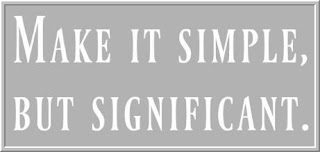Many traders that I work with involve me in their performance reviews. Sometimes they create weekly reviews, sometimes monthly or quarterly. Invariably these reviews summarize what they did wrong over this period and how they could improve. They set lots of goals, but then that's often the last I hear about those goals until the next review period!
There are three big problems with the goal-setting of many (and perhaps most) traders:
1) Too Many Goals - By setting a large number of goals, traders have difficulties prioritizing the changes they want to make, and they find it difficult to give each of the goals proper attention. As a result, they chronically feel as though they are falling short in achieving their goals and lose motivation. Goals should move us forward, not discourage us!
2) Vague Goals - A trader may set a goal of trading with greater discipline, so that they stop overtrading. Great! How are they going to do that? How will they monitor performance to know that they're making progress? A vague goal is only a good intention; it's not likely to energize or shape performance. My experience is that vague goals get the least follow-through.
3) Goals Lacking Vision - The best goals are tied to a vision of what is possible. We want goals to bring out the best in us. We want goals to excite and challenge us. Many of the goals set by traders are prioritized to-do lists. That turns the pursuit of goals into chores, robbing us of energy and enthusiasm. If there's no emotion and excitement associated with our goals, we're unlikely to put forth our best efforts toward change.
In short, we don't see things as they are; we see them as *we* are. Our moods and energy level help shape our perceptions and actions. If we are overloaded with too many goals, vague goals, and goals not tied to an inspiring vision of the future, we are likely to lose our passion for markets and trading.
Consider the radically different alternative of FIGS: Focused, Intensive Goal Setting. What if, at any given time, we worked on one goal and one goal only. Suppose we worked on it every single day and made it the focus on each day's efforts. And suppose we made it an emotionally intensive goal, where we actively rehearse and *feel* the consequences of not reaching the goal and the joy and benefits of making progress on the goal. Suppose we grow--as people and as traders--by working one goal at a time in FIGS fashion, rather than by creating laundry lists of changes that are "shoulds" rather than "musts".
We see FIGS at work among people who work on their recovery from drug and alcohol dependence and addiction. At some point, they "hit bottom" and make recovery their number one life priority. They attend AA meetings every day, connect with a sponsor who helps them through rough patches, and work on their sobriety one day at a time. What makes such change efforts powerful is the emotional commitment to reaching goals. After someone has hit bottom, they *hate* their old habits and ways. They never want to go back to the consequences they created for themselves and others. Their goals are focused, but also intensive, because the goals aren't mere items on a list or in a journal. The goals carry emotional intensity.
We don't change because we want to. We change because we must: we *need* to. Without urgency, we don't sustain change efforts and simply relapse into old ways. When goal setting is focused and intensive, we more readily create the conditions of urgency that help us see ourselves and others in new ways.
FIGS starts with a simple question: What changes do you need to make?
Further Reading:
.























